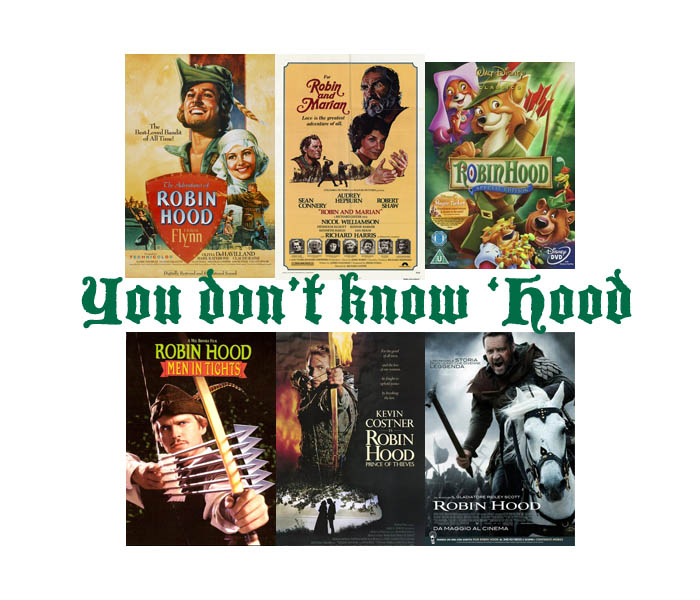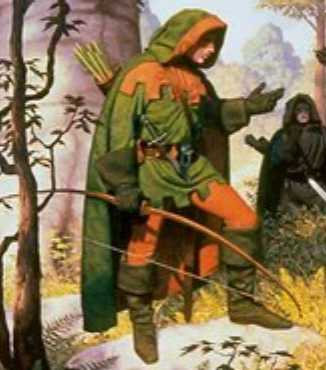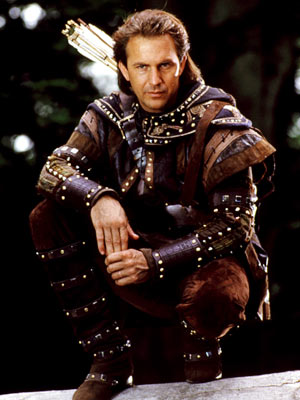The legend of Robin Hood has withstood if not aced the test of time, lasting centuries and still appealing to audiences even in this modern age with yet another reincarnation coming to theaters on Friday courtesy Ridley Scott. Even the youngest of school children know the basic story about the character, but whatever you know about Robin Hood, leave it at the end of this sentence, because we're about to change your whole mental framework about the man, the myth and the green-tighted legend.
Yet a legend like Robin Hood has been re-written countless times and like with many great stories misconceptions are created. The original ideas behind the story are slowly lost in the public consciousness, much like with Mary Shelley's Frankenstein. He has been in poems, ballads, novels and dozens of films and TV series, from the capacity of the central character to a minor cameo and has been treated as deadly serious, to comic fodder. Here is a lot back at how Robin Hood has changed for the 800 years of his existence.
The legend has been adapted a variety of ways. There's the simple adventure where a hero saves a damsel in distress and protects the people from a brutal authority figure. Then there's the more mature commentary and criticism of medieval government and an opportunity for the lower classes to develop their own culture. Then of course there's the pseudo-Marxist interpretation with regards to the concept of wealth distribution.
The idea of Robin Hood as a concept has lasted through the ages, continually being re-written and influencing other cultural phenomena, such as the hero worship of highwaymen in the Georgian era of England, Wild West outlaws, Depression era criminals like John Dillinger and Bonnie and Clyde and even some comic-book heroes. Medieval Europe is notoriously one of the most brutal periods in history, with people being robbed regularly, nations raiding each others' borders and routinely raping the women -- war was happening somewhere on the continent at any given moment.
Medieval Europe is notoriously one of the most brutal periods in history, with people being robbed regularly, nations raiding each others' borders and routinely raping the women -- war was happening somewhere on the continent at any given moment.
It is very debatable whether Robin Hood really existed and where the outlaw would have been from: the two main sites in contention are Sherwood Forest, Nottinghamshire and Barnsdales, South Yorkshire. The earliest reference to the outlaw was in 1228, when the name appeared on the roles of many justices in various forms. These references continued way beyond the likelihood a person could realistically live. If Robin Hood really existed then he influenced a lot copycats.
Stories about Robin Hood were originally oral tales. This was a strong sign of storytelling in lower-class culture, different to say Geoffrey Chaucer whose work was aimed for the upper classes. But the tales were also a strong symbol of resistance to the upper classes of the time.
The earliest literary source that mentions Robin Hood was in William Langford’s poem Piers Plowman, written between 1362 to 1383. It was a grand total of one sentence. Other poems were written afterward and focused more on the outlaw. The poems and stories ended up ranging from straight-forward action-adventure where Robin Hood wasn't shy to using violence to more comic stories in which Robin Hood was more cunning and used forces as a last resort.
By the Elizabethan era, the legend was changing to make the character more acceptable to the upper classes. The biggest was turning Robin from being a commoner to a wronged noble fighting to get his land and titles back. Heroes in this period were always from the nobility. The setting of the stories was also changed from anytime between 1272 to 1377 (the reign of the King Edward) to the late 1190s, making Robin Hood out to be a soldier returning from the Crusades who ends up fighting local corruption.
commoner to a wronged noble fighting to get his land and titles back. Heroes in this period were always from the nobility. The setting of the stories was also changed from anytime between 1272 to 1377 (the reign of the King Edward) to the late 1190s, making Robin Hood out to be a soldier returning from the Crusades who ends up fighting local corruption.
More characters were added to the stories at this time, namely Friar Turk and Maid Marion. Friar Turk was added to be a comic character and basically a chance to criticize Catholicism after England adopted Protestantism, while Maiden was introduced to be a love interest, which of course only added to the durability of the legend
In the Victorian period, the stories got another re-write, making them more child-friendly and strengthening the idea that Robin Hood gave his taking to the poor. This period added the concept that Robin Hood was a Saxon who was fighting against Norman oppressors in the Nottingham area. Robin Hood was even briefly mentioned in the Sir Walter Scott Ivanhoe.
So we enter the modern era, where the Robin Hood legends were adapted into film and television programs. The first major film was a silent picture in 1922 starring Douglas Fairbanks, but one the most-remembered was the 1939 film The Adventures of Robin Hood starring swashbuckling film star Errol Flynn, centered around the hero starting a national rebellion against Prince John. It was a successful family adventure and still has an audience today. It partly explains why the character has been revisited so often.
Robin Hood continued as a source of family entertainment. There were TV series such as The Adventures of Robin Hood, Robin of Sherwood and Robin Hood (2006). All these series took a different direction with the legend. Robin of Sherwood used fantasy elements in its storytelling and Robin Hood (2006) showed the origins of the hero, attempting to be a Doctor Who of sorts by being clever through comparing the relationship between England and the Vatican to the Blair/Bush relationship.
The 1973 Disney version was also a popular hit with children and made Robin and Maiden into anthropomorphic foxes. Other films have also reinvented the legend, Robin and Maiden attempted to show an older Robin with Sean Connery as the hero and Robin Hood: Prince of Thieves mixed comedy and more violence into the film world (but kept a PG rating).
 In the noughts, the BBC commissioned a TV series, but it was met with a lukewarm reception. It was plagued by weak writing, unnecessary attempts at political metaphors and being too politically correct for its own good. Robin Hood (2010) is the first major film about Robin in the last 19 years and it's directed by Sir Ridley Scott (Gladiator, Kingdom of Heaven), a man who knows how to make a good epic. This version, like previous modern versions, is set in the late 12th Century with Robin rebelling against the usual villains, Prince John and the Sheriff of Nottingham. However, this is going to be more then a simple tale of a group of men who fighting against a tyrant, but taking a deeper look into medieval ideology, rebelling against a system of kingship and feudalism: much like Gladiator did with the idea of legacy and the politics of the Roman Empire. Robin Hood (2010) aims to be a more gritty and realistic to previous Robin Hood stories, showing that the Medieval period was a violent and dirty time.
In the noughts, the BBC commissioned a TV series, but it was met with a lukewarm reception. It was plagued by weak writing, unnecessary attempts at political metaphors and being too politically correct for its own good. Robin Hood (2010) is the first major film about Robin in the last 19 years and it's directed by Sir Ridley Scott (Gladiator, Kingdom of Heaven), a man who knows how to make a good epic. This version, like previous modern versions, is set in the late 12th Century with Robin rebelling against the usual villains, Prince John and the Sheriff of Nottingham. However, this is going to be more then a simple tale of a group of men who fighting against a tyrant, but taking a deeper look into medieval ideology, rebelling against a system of kingship and feudalism: much like Gladiator did with the idea of legacy and the politics of the Roman Empire. Robin Hood (2010) aims to be a more gritty and realistic to previous Robin Hood stories, showing that the Medieval period was a violent and dirty time.
The term historically accurate should be used very loosely when it comes to Robin Hood, seeing that it’s debatable that he even existed. But there are going to be some historical inaccuracies in the new film, like a noble being an excellent archer with a longbow, a weapon used by commoners, farmers and yeomen. Nobles preferred to fight in armor as knights and men-at-arms. Prince John also has a bit of an unfair reputation whilse ruling for his brother, having to raise taxes for Richard I’s wars abroad, compared to Richard I who only spend six months of his 10-year reign in England.
However Scott has shown himself to a balanced director, showing both sides of the coin and arguing in his historical films that there is a complex picture, such as in Kingdom of Heaven where there were good and bad characters in both camps and Muslims were shown in a mostly decent and honorable light. It's better than Mel Gibson’s direction of Braveheart where the Scots were all good Catholics who were fighting against the evil, tyrannical, stupid oppressors the English in a horribly one-dimensional film.
Robin Hood has had an enduring legacy and the stories have lasted for just under 800 years. There is an obvious appeal of the stories and Robin Hood (2010) is bound to a financial success for this very reason. The stories are open to interpretation so new versions of Robin Hood can always be created for film, television, comics, novels and video games, and his influence and ideas have expanded beyond his medieval realm.